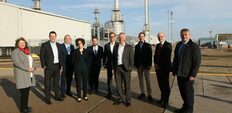
Project Overview
Kellas, along with BlackRock and GIC, announced the development of H2NorthEast, a low carbon hydrogen facility in Teesside. The project aims to build a 1GW facility producing blue hydrogen using UK North Sea natural gas processed at the existing CATS Terminal. Over 95% of the CO2 produced will be captured and stored offshore through the Northern Endurance Partnership.
Strategic Importance
H2NorthEast aligns with the UK government’s strategy to create a hydrogen economy, contributing 20% of the target 5GW blue hydrogen capacity by 2030. The project responds to customer demand and aims to decarbonize industry in Teesside.
Economic Impact
The project is expected to create around 1,200 construction jobs over a three-year period and 400 long-term operational roles for at least 25 years. Tees Valley Mayor, Ben Houchen, highlighted the project's potential to bring over 1,000 jobs during construction and hundreds of high-quality, well-paid roles in the long term.
Decarbonization Goals
Kellas has submitted an application for H2NorthEast as part of BEIS’ cluster application under the East Coast Cluster bid. If successful, this will be the largest industrial decarbonization project in the UK, targeting up to 27 million tonnes of CO2, representing 50% of the UK’s industrial cluster carbon emissions. The ambition is for H2NorthEast to be operational by the end of 2027, saving over 2 million tonnes of CO2 emissions annually.

